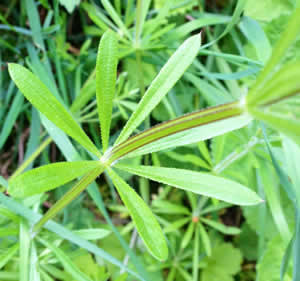Positive Health Online
Your Country

Galium Aparine - Cleavers for Spring Cleansing
listed in herbal medicine, originally published in issue 221 - April 2015
One of the first wild herbs to appear in hedgerows in spring is cleavers. Also known as goosegrass as geese enjoy eating it, this common ‘weed’ is native to Europe and recognized by its long stems and seeds which stick to anything they touch. Along its leaves are tiny curved bristles that cling onto and climb up nearby plants and structures. Its species name aparine comes from the Greek meaning 'to seize' reflected in common names including catchweed, sticky willy, everlasting friendship, sweethearts and loveman.

Cleavers is a member of the Rubiaceae or bedstraw family, as with their aroma of newly mown hay or honey, they were used to make mattresses. The genus name Galium comes from gala, Greek for milk. Apparently in ancient Greece as in modern Sweden, shepherds have used the stems to make a sieve to strain milk; plants in the Galium family have been used as 'vegetable rennet’ as they contain enzymes which encourage milk to curdle; another common name, milk sweet, refers to this.
The aerial parts provide a wonderful spring-cleansing remedy, clearing toxins through diuretic, hepatic and mild laxative actions and by promoting lymphatic circulation. Traditionally cleavers has been taken in spring to as a cooling drink or eaten as a vegetable to ‘clear the blood’. The young tops can be added raw to salads and green smoothies, or cooked as a vegetable and added to soups and stews. The dried seeds can be roasted and ground to make a coffee substitute.
Cleavers supports the lymphatic system in its cleansing and immune work and is used for treating swollen lymph glands, lymphatic congestion and swollen breasts, as well as for glandular fever, post-viral fatigue and tonsillitis. It may have anti-tumour activity, especially in the skin, the lymphatic system and breasts. The juice of the fresh herb is recommended in this instance.
According to Thornton's New Family Herbal (1810), "Dioscorides mentions an ointment of great efficacy made from the expressed juice of this plant mixed with hog's lard for discussing tumours in the breast; and Gaspian, an Italian, adopted the same with great success. After some eminent surgeons have failed, I have ordered the expressed juice mixed with linseed meal, to be applied to the breast, with a teaspoon of the same to be taken while fasting in the morning; and this plan after a short time has removed very frightful and indolent tumours of the breast.” In a recent investigation of 21 herbs for their anti-oxidant activity and inhibition of proteinases, useful in inhibition of viruses and tumours, positive results were gained from cleavers.[1] Other studies have demonstrated the anti-tumour effect of a number of herbs including cleavers.[2]
Cleavers’ slightly bitter taste stimulates the flow of bile, aids the liver in its detoxifying work and improves digestion, especially of fats. Research has demonstrated its hepato-protective effect;[4] it may be helpful in hepatitis and mild constipation.
With an affinity with the urinary system, cleavers aids elimination of excess fluid, wastes and toxins via the kidneys. It is used for urinary gravel and stones, infections, cystitis, irritable bladder and prostate problems. It was an old wives' remedy for losing weight; Culpeper said, "It is familiarly taken in broth to keep them lean and lank that are apt to grow fat".
Cleavers may lower blood pressure, perhaps through its diuretic action. Asperuloside, one of its constituents, may also have a hypotensive action. A number of studies have shown that cleavers can lower high blood pressure without demonstrating toxicity.[1]
Its diuretic properties augment the function of the lymphatic system in its detoxifying work; this can be helpful in the treatment of skin problems like acne, rosacea, eczema, psoriasis, abscesses and boils, as well as for gout and arthritis. Studies have investigated 23 herbs including cleavers for potential anti-bacterial action and noted positive effects against Staphylococcus aureus[3]
When taken as a hot tea, cleavers brings blood to the surface and causes sweating, useful in lowering fevers and clearing toxins and wastes via the skin. This diaphoretic action helps bring out the rash in childhood eruptive infections like measles and chicken pox, speeding infection on its way. Mixed with pleasant-tasting herbs such as lemon balm or mint, it is easy to swallow!
Externally a cool infusion of cleavers can be used to bathe scalds and burns, cuts and abrasions, sunburn, inflammatory skin problems such as eczema, psoriasis and acne, and as a hair rinse for dandruff or seborrhoea. The bruised fresh leaves can be applied to cuts or wounds to check bleeding and speed healing. The juice or an infusion can be used to bathe varicose ulcers, or the fresh leaves can be made into a poultice.
The constituents in cleavers include tannins (gallotannic acid), citric acid, flavonoids (luteolin), iridoid glycosides (including asperuloside), polyphenolic acids, alkanes, saponins, coumarins and scopoletin. It has the following actions: antioxidant, alterative, depurative, lymphatic, diuretic, hepatic, cholagogue, astringent, vulnerary, anti-inflammatory, anti-tumour, hypotensive, immune-stimulant, febrifuge, refrigerant and diaphoretic.
Note that the sap of the fresh plant may irritate the skin in susceptible people, and to avoid taking with diuretic medicines, including loop diuretics, Spironolactone, Thiazide diuretics, and Triamterene.[5]
References
1.Tamsyn SA Thring, Pauline Hili and Declan P Naughton, Anti-collagenase, anti-elastase and anti-oxidant activities of extracts from 21 plants, BMC Complement Altern Med. 9: 27. 2009.
2. Elizabeth A. Mazzio and Karam F. A. Soliman, In Vitro Screening for the Tumoricidal Properties of International Medicinal Herbs, Phytother Res. 23(3): 385-398. March 2009.
3. Romero et al; Journal of Ethnopharmacology, Volume 99, Issue 2: 253-257. 3 June 2005.
4. Muhammad Aman Khan, Jehanzeb, Shafiullah, Salman A Malik, Muhammad Shafi, Hepato-protective effects of Berberis lycium, Galium aparine and Pistacia integerrima in Carbon tetrachloride (ccl4)-treated rats, J Postgrad Med Inst 22(2):91-4. Apr - Jun 2008.
5. Simon Mills and Kerry Bone. 2005 The Essential Guide To Herbal Safety, Churchill-Livingstone. 2005.
Comments:
-
No Article Comments available